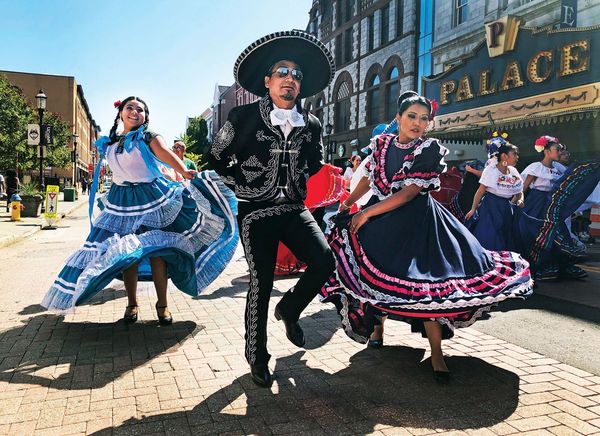(Subscribe to The Brass File to get it e-mailed directly to your in-box by clicking on the link at the bottom of this page. Thank you.)
Story By John Murray
Near the kitchen entrance in the back of Mojo Nuevo Latin Cuisine on East Main Street, Governor Ned Lamont was leaning into a conversation with alderman George Noujaim, and State Representative Geraldo Reyes Jr..
“Why are Hispanics coming here?” Lamont asked. “What is bringing them to Waterbury?”

Connecticut Governor Ned Lamont questioning George Noujaim and Geraldo Reyes. |
Noujaim is a real estate agent and Reyes is the Chairman of the Black and Puerto Rican Caucus in the State Legislature. Lamont was seeking insight into the 2020 Census data that revealed that the Hispanic population in Connecticut was up 30% in the past decade, and Waterbury’s population was now 37% Hispanic, with thousands more undocumented and uncounted living in the shadows.
Waterbury’s population is now 38% Whites, 37% Hispanics, 19% Blacks and 6% Asians, Pacific Islanders, Native Americans and others.
“There is a real estate boom in Waterbury,” Reyes said. “The price point is great, and many families are leaving NYC to improve their quality of life.”
Reyes told the Governor about the Town Plot neighborhood in Waterbury where the three houses around his daughter’s house were recently purchased by families from Ecuador, the Dominican Republic and Mexico, all relocating from NYC.
“I spoke with the three families and they all said they had improved the quality of their children’s education by moving to Waterbury,” Reyes said. “And they couldn’t believe the size of the houses they could get for $200,000.”
Lamont was in Waterbury to kick off National Hispanic Heritage Month which runs from September 15th through October 15th. The date of September 15th is significant because it is the anniversary of independence for Latin American countries Costa Rica, El Salvador, Guatemala, Honduras and Nicaragua. In addition, Mexico and Chile celebrate their independence days on September 16th and September 18th.
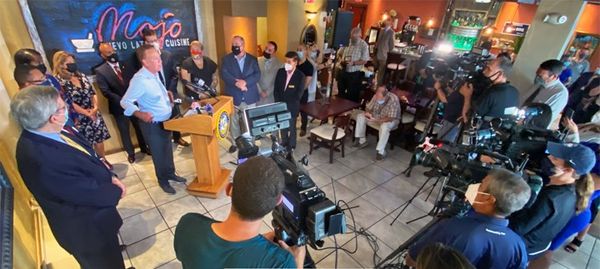
Governor Ned Lamont addressed the media inside Mojo Nuevo Latin Cuisine. |
For the past 50 years Americans have observed National Hispanic Heritage Month by celebrating the histories, cultures and contributions of American citizens whose ancestors came from Spain, Mexico, the Caribbean and Central and South America.

Folkloric dancer from Peru at The Gathering. |
The Governor’s Office had reached out to Reyes on September 13th and said they wanted to hold an event in Waterbury, and asked if could he find an appropriate location for the event. Reyes selected Mojo because the restaurant had been hard hit during the COVID pandemic, and had been closed for eight months.
It was a significant moment for Mojo as Governor Lamont, Congresswoman Jahana Hayes, Waterbury Mayor Neil O’Leary, three Hispanic State Commissioners, and more than a dozen journalists attended the press conference. Reyes acted as the master of ceremony.

State Representative Geraldo Reyes Jr. |
Cuban-born Jorge Perez is the state commissioner of banking and spoke about the Hispanic boom across Connecticut. “We are the majority-minority group,” Perez said. “Things aren’t changing, they’ve changed.”
As a case in point, four years ago there were no Hispanic commissioners in Governor Dan Malloy’s administration, and now there are three in Lamont’s administration (and there were four until Miguel Cardona left the Connecticut Department of Education to become Secretary of Education in President Joe Biden’s administration).
Selia Mosquera-Bruno heads the state’s Department of Housing and moved to Connecticut from Ecuador when she was 23 years old. Her first job was in a factory making $5.75 and hour, but she used an ESL program to get into college and eventually a earn a Master’s Degree and a fellowship to Harvard University.
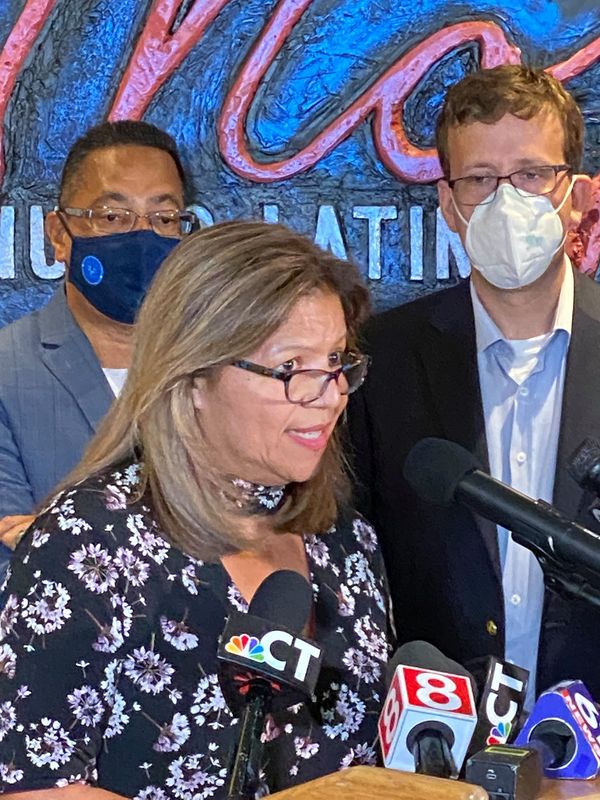
Selia Mosquera-Bruno is Connecticut’s Commissioner of Housing. |
“My grandmother instilled in me a strong work ethic and now I’m the first Latina commissioner in state history,” Mosquera-Bruno said. “My message to the youth is everything is possible. Education is the key to getting out of poverty.”
During a wide sweeping press conference inside Mojo the elected officials tackled questions on education, COVID’s unequal impact on communities of color, immigration, executive power, and the burgeoning Hispanic population in Connecticut.
“It’s important to remember where we all came from,” Governor Lamont said. “It’s our amazing diversity that makes us special.”
Teaching the history of Blacks and Hispanics in Connecticut public schools is currently optional, but Reyes said the Black and Puerto Rican Caucus is seeking to make it mandatory in classrooms during the next legislative session in Hartford.
“Cross cultural learning benefits everyone,” Reyes said, “The more we learn about each other the better we all are.”
Lamont agreed.
“Not everyone came here on the Mayflower,” Lamont said. “If you’re not learning how people came here from Africa, Ireland, Italy and everywhere else, you’re not learning American history.”
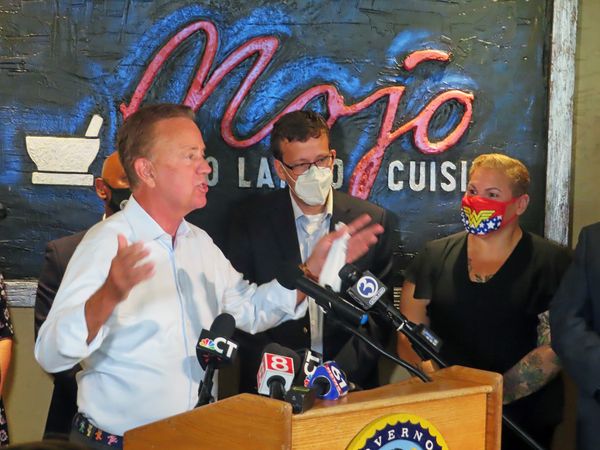
Governor Lamont fielded questions about his executive powers and COVID vaccines. |
Congresswoman Hayes, a former National Teacher of the Year, taught Black and Hispanic history in classes she instructed at Kennedy High School.
“It wasn’t just Black and Brown students taking the class,” she said. “Students of every color were interested, and it’s good for all of us to learn the history of every group.”
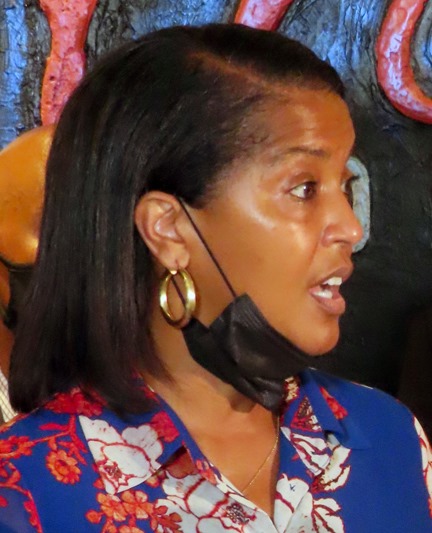
Congresswoman Jahana Hayes |
Lamont and Reyes and O’Leary all spotlighted the extraordinary diversity in Waterbury. O’Leary has spent 40 years working in Waterbury as a police officer (30 years) and mayor (10 years) and said the change in the city demographics since 1980 has been stunning.
“It’s amazing the number of Hispanics who have chosen Waterbury as their home,” O’Leary said. “There used to be very little minority representation on boards and commissions, now we have six on the Board of Aldermen and I’m proud of that.”
And the new wave of immigrants to Waterbury are proud of their culture, particularly the ones from Ecuador, Mexico, the Dominican Republic and Central America who came out strong at The Gathering, a multi-cultural celebration of global culture held in downtown Waterbury from 2013 through 2019 (the last two have been cancelled out of COVID concerns).
Hopefully the next festival will be in September 2022, during National Hispanic Heritage Month, and 15,000 visitors will shoehorn into downtown Waterbury to again celebrate music, food and dance from around the world, including Bomba y Plena (Puerto Rican), Salsa (Cuban and Puerto Rican), Merengue (Dominican), Marinera (Peru) and Mariachi (Mexican).
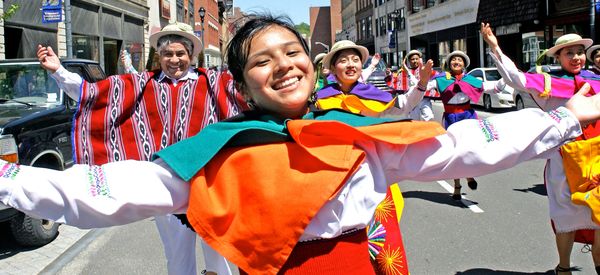
Dancers from Ecuador at The Gathering in downtown Waterbury. |
Waterbury is an extraordinarily diverse city, perhaps as diverse as any city its size in America. Waterbury public school students speak 44 different languages, and by learning about each other’s cultures the community strengthens its bonds.
At the end of the press conference Governor Lamont ate lunch inside Mojo with Reyes and Hayes and his three Hispanic commissioners. They ate rice and beans, mofongo and plantains, and talked about life.
A tasty way to kick off Hispanic Heritage Month.

